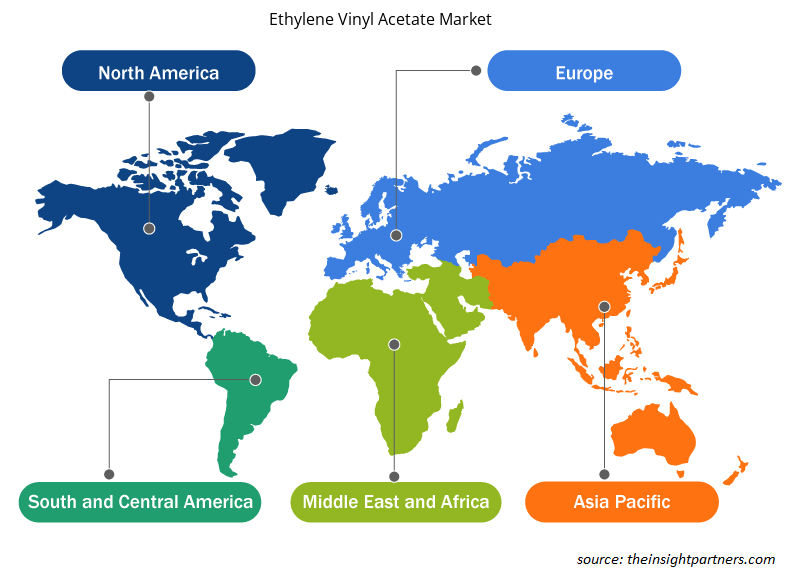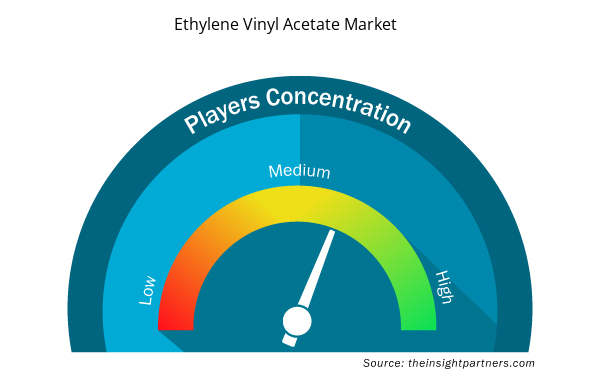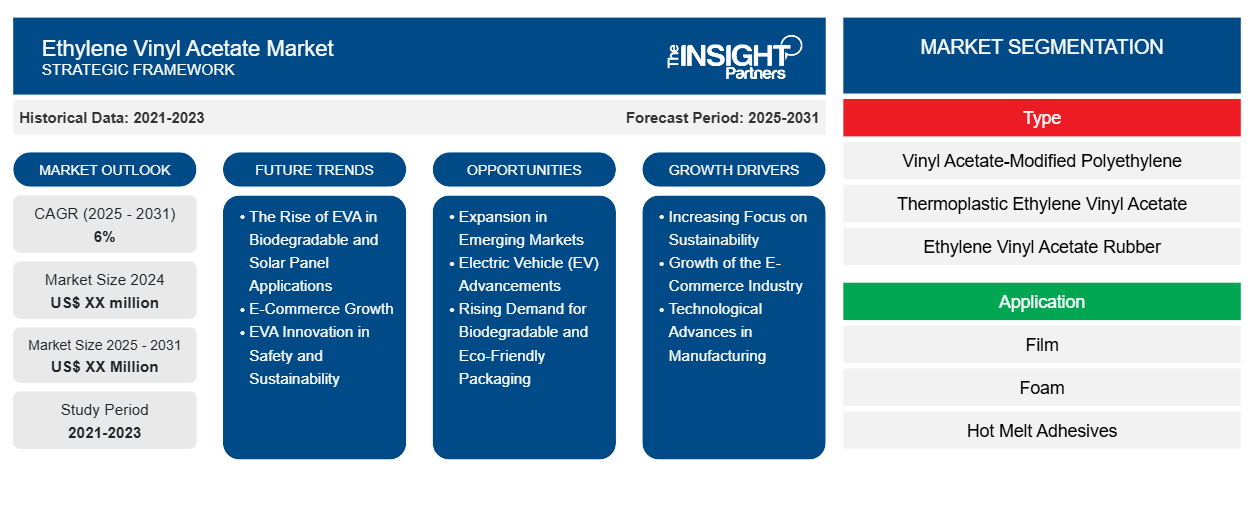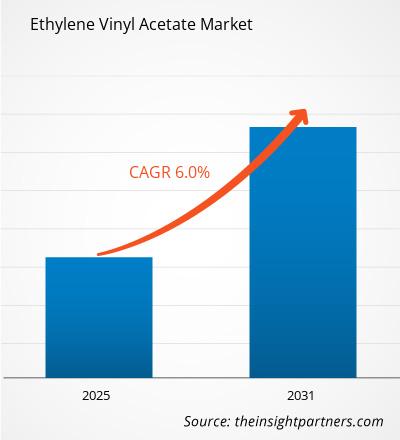Der Markt für Ethylen-Vinylacetat wird voraussichtlich von 2024 bis 2031 eine durchschnittliche jährliche Wachstumsrate (CAGR) von 6 % verzeichnen, wobei die Marktgröße von XX Millionen US-Dollar im Jahr 2024 auf XX Millionen US-Dollar bis 2031 wachsen wird.
Der Markt für Ethylenvinylacetat umfasst Analysen nach Typ (Vinylacetat-modifiziertes Polyethylen (niedrige VA-Dichte), thermoplastisches Ethylenvinylacetat (mittlere VA-Dichte), Ethylenvinylacetat-Kautschuk (hohe VA-Dichte)); Anwendung (Folie, Schaum, Schmelzklebstoffe, Drähte (und) Kabel, Extrusionsbeschichtung, Solarzellenverkapselung, Sonstiges); Endverbraucher (Automobil, Verpackung (und) Papier, Farben (und) Beschichtungen (und) Klebstoffe, Elektronik (und) Elektrik, Pharmazie, Schuhe, Photovoltaikmodule, Sonstiges) und Geografie (Nordamerika, Europa, Asien-Pazifik, Naher Osten und Afrika sowie Süd- und Mittelamerika). Ethylenvinylacetat oder EVA wird durch Copolymerisation von Ethylen und Vinylacetat mit einem variierenden Gewichtsanteil von Vinylacetat bis zu 40 % gewonnen, der Rest ist Ethylen.
Zweck des Berichts
Der Bericht Ethylenvinylacetat-Markt von The Insight Partners zielt darauf ab, die gegenwärtige Landschaft und das zukünftige Wachstum sowie die wichtigsten treibenden Faktoren, Herausforderungen und Chancen zu beschreiben. Dies wird verschiedenen Geschäftspartnern Einblicke geben, wie zum Beispiel:
- Technologieanbieter/-hersteller: Um die sich entwickelnde Marktdynamik zu verstehen und die potenziellen Wachstumschancen zu kennen, damit sie fundierte strategische Entscheidungen treffen können.
- Investoren: Durchführung einer umfassenden Trendanalyse hinsichtlich der Marktwachstumsrate, der finanziellen Marktprognosen und der Chancen entlang der Wertschöpfungskette.
- Regulierungsbehörden: Zur Regulierung von Richtlinien und Überwachungsaktivitäten auf dem Markt mit dem Ziel, Missbrauch zu minimieren, das Vertrauen der Anleger zu bewahren und die Integrität und Stabilität des Marktes aufrechtzuerhalten.
Ethylenvinylacetat Marktsegmentierung
Typ
- Vinylacetat-modifiziertes Polyethylen
- Thermoplastisches Ethylenvinylacetat
- Ethylen-Vinylacetat-Kautschuk
Anwendung
- Film
- Schaum
- Schmelzklebstoffe
- Drähte Kabel
- Extrusionsbeschichtung
- Verkapselung von Solarzellen
- Sonstiges
Passen Sie diesen Bericht Ihren Anforderungen an
Sie erhalten kostenlos individuelle Anpassungen an jedem Bericht, einschließlich Teilen dieses Berichts oder einer Analyse auf Länderebene, eines Excel-Datenpakets sowie tolle Angebote und Rabatte für Start-ups und Universitäten.
- Holen Sie sich die wichtigsten Markttrends aus diesem Bericht.Dieses KOSTENLOSE Beispiel umfasst eine Datenanalyse von Markttrends bis hin zu Schätzungen und Prognosen.
Wachstumstreiber auf dem Ethylenvinylacetat-Markt
- Zunehmender Fokus auf Nachhaltigkeit: EVA wird zunehmend in umweltfreundlichen Anwendungen wie biologisch abbaubaren Verpackungen, Solarmodulen und Schuhen eingesetzt. Da Unternehmen aus Umweltgründen und aufgrund des Drucks durch Vorschriften zu umweltfreundlicheren Alternativen übergehen, ist EVA aufgrund seiner Vielseitigkeit ein bevorzugtes Material. Seine Verwendung in umweltbewussten Branchen, insbesondere in den Bereichen erneuerbare Energien und Verpackung, unterstützt seine wachsende Nachfrage.
- Wachstum der E-Commerce-Branche: Da der E-Commerce schnell an Umfang zugenommen hat, ist die Nachfrage auf dem Markt nach leichtem, aber dennoch starkem und billigem Verpackungsmaterial deutlich gestiegen. EVA gewinnt aufgrund seiner Schutzeigenschaften an Bedeutung und ist relativ leicht, sodass es als Polsterung dienen kann. Darüber hinaus erhöht das schnelle Wachstum des Online-Shoppings auf der ganzen Welt die Notwendigkeit nachhaltiger Verpackungen, was den Markt für die Einführung von EVA-Verpackungen weiter vorantreibt.
- Technologische Fortschritte in der Fertigung: Das Aufkommen neuer EVA-Typen mit verbesserten Eigenschaften wie erhöhter Haltbarkeit, Flexibilität und Widerstandsfähigkeit gegen Umweltbelastungen treibt die Nutzung des Materials in einer Reihe von Anwendungen voran. Innovationen im Herstellungsprozess, wie die Verwendung von Rohstoffen auf biologischer Basis, steigern die Attraktivität von EVA für Unternehmen, die gesetzliche Standards und die Verbrauchernachfrage nach nachhaltigen, leistungsstarken Produkten erfüllen möchten, noch weiter.
Zukünftige Trends auf dem Ethylen-Vinylacetat-Markt
- Der Aufstieg von EVA in biologisch abbaubaren und Solarmodul-Anwendungen: Diese werden im Einklang mit dem Umweltbewusstsein mengenmäßig immer wichtiger. Angesichts des globalen Trends zur Nachhaltigkeit bei der Materialbeschaffung wird EVA jetzt in umweltfreundlichen Anwendungen eingesetzt, darunter biologisch abbaubare Produkte und das Innere von Solarmodulen.
- Wachstum im E-Commerce: Der wachsende E-Commerce-Markt wird voraussichtlich die Nachfrage nach EVA in Verpackungslösungen steigern. Das Produkt bietet Schutzeigenschaften bei geringem Gewicht. Daher wird sich dieser Trend in einer Weise ändern, die Innovationen bei der Gestaltung von Verpackungsmaterialien begünstigt und den Schwerpunkt auf Haltbarkeit sowie den nachhaltigen Versand von Produkten online legt.
- EVA-Innovation in puncto Sicherheit und Nachhaltigkeit: Änderungen der Vorschriften zur Materialsicherheit und zu den ökologischen Auswirkungen werden für die EVA-Märkte eine entscheidende Rolle spielen. Unternehmen werden durch diese Vorschriften gezwungen; es ist gut möglich, dass sie zur Einhaltung dieser Vorschriften weitere Innovationen bei der Entwicklung sichererer und weniger gefährlicher Produkte mit ökologischen Auswirkungen vorantreiben.
Marktchancen für Ethylenvinylacetat
- Expansion in Schwellenmärkte: Mit der zunehmenden Urbanisierung und Industrialisierung in Schwellenländern besteht ein enormes Potenzial für EVA in den Bereichen Verpackung, Schuhe, Automobilbau und Bauwesen, um nur einige zu nennen. Angesichts der steigenden verfügbaren Einkommen und des wachsenden Umweltbewusstseins bieten diese Regionen eine enorme Wachstumschance für EVA-Hersteller.
- Fortschritte bei Elektrofahrzeugen (EV): Die hervorragende Isolierung und das geringe Gewicht von EVA machen es zu einem wertvollen Automobilmaterial, insbesondere für Elektrofahrzeuge. Da weltweit der Schwerpunkt auf sauberem Transport liegt, sind Kapselungen für Batterien, Innenraumkomponenten und andere leichte Automobilteile Möglichkeiten, die mit der zunehmenden Verbreitung von Elektrofahrzeugen an Bedeutung gewinnen werden.
- Steigende Nachfrage nach biologisch abbaubaren und umweltfreundlichen Verpackungen: Das wachsende Bewusstsein für die Umweltverschmutzung durch Kunststoffe hat auf dem Markt einen neuen Raum für nachhaltige Verpackungsalternativen eröffnet. EVA in biologisch abbaubaren Verpackungen, insbesondere für Einweganwendungen in der Lebensmittelverpackung, bietet eine lohnende Chance. Da sowohl Verbraucher als auch Regulierungsbehörden auf umweltfreundlichere Lösungen setzen, kann EVA diesen Trend nutzen und sich als größter Akteur in der „grünen Verpackungsrevolution“ etablieren.
Regionale Einblicke in den Ethylenvinylacetat-Markt
Die regionalen Trends und Faktoren, die den Ethylenvinylacetat-Markt während des Prognosezeitraums beeinflussen, wurden von den Analysten von Insight Partners ausführlich erläutert. In diesem Abschnitt werden auch die Marktsegmente und die Geografie von Ethylenvinylacetat in Nordamerika, Europa, im asiatisch-pazifischen Raum, im Nahen Osten und Afrika sowie in Süd- und Mittelamerika erörtert.

- Erhalten Sie regionale Daten zum Ethylenvinylacetat-Markt
Umfang des Marktberichts über Ethylenvinylacetat
| Berichtsattribut | Details |
|---|---|
| Marktgröße im Jahr 2024 | XX Millionen US-Dollar |
| Marktgröße bis 2031 | XX Millionen US-Dollar |
| Globale CAGR (2024 - 2031) | 6 % |
| Historische Daten | 2021-2023 |
| Prognosezeitraum | 2025–2031 |
| Abgedeckte Segmente | Nach Typ
|
| Abgedeckte Regionen und Länder | Nordamerika
|
| Marktführer und wichtige Unternehmensprofile |
|
Marktteilnehmerdichte für Ethylenvinylacetat: Auswirkungen auf die Geschäftsdynamik verstehen
Der Markt für Ethylenvinylacetat wächst rasant, angetrieben durch die steigende Endverbrauchernachfrage aufgrund von Faktoren wie sich entwickelnden Verbraucherpräferenzen, technologischen Fortschritten und einem größeren Bewusstsein für die Vorteile des Produkts. Mit steigender Nachfrage erweitern Unternehmen ihr Angebot, entwickeln Innovationen, um die Bedürfnisse der Verbraucher zu erfüllen, und nutzen neue Trends, was das Marktwachstum weiter ankurbelt.
Die Marktteilnehmerdichte bezieht sich auf die Verteilung von Firmen oder Unternehmen, die in einem bestimmten Markt oder einer bestimmten Branche tätig sind. Sie gibt an, wie viele Wettbewerber (Marktteilnehmer) in einem bestimmten Marktraum im Verhältnis zu seiner Größe oder seinem gesamten Marktwert präsent sind.
Die wichtigsten auf dem Ethylen-Vinylacetat-Markt tätigen Unternehmen sind:
- Arkema-Gruppe
- Braskem
- Celanese Corporation
- China Petroleum & Chemical Corporation
- EI du Pont de Nemours und Company
Haftungsausschluss : Die oben aufgeführten Unternehmen sind nicht in einer bestimmten Reihenfolge aufgeführt.

- Überblick über die wichtigsten Akteure auf dem Ethylen-Vinylacetat-Markt
Wichtige Verkaufsargumente
- Umfassende Abdeckung: Der Bericht deckt die Analyse von Produkten, Dienstleistungen, Typen und Endbenutzern des Ethylenvinylacetat-Marktes umfassend ab und bietet einen ganzheitlichen Überblick.
- Expertenanalyse: Der Bericht basiert auf dem umfassenden Verständnis von Branchenexperten und Analysten.
- Aktuelle Informationen: Der Bericht stellt durch die Abdeckung aktueller Informationen und Datentrends Geschäftsrelevanz sicher.
- Anpassungsoptionen: Dieser Bericht kann angepasst werden, um den spezifischen Kundenanforderungen gerecht zu werden und die Geschäftsstrategien optimal anzupassen.
Der Forschungsbericht zum Ethylenvinylacetat-Markt kann daher dabei helfen, die Branchensituation und Wachstumsaussichten zu entschlüsseln und zu verstehen. Obwohl es einige berechtigte Bedenken geben kann, überwiegen die allgemeinen Vorteile dieses Berichts tendenziell die Nachteile.
- Historische Analyse (2 Jahre), Basisjahr, Prognose (7 Jahre) mit CAGR
- PEST- und SWOT-Analyse
- Marktgröße Wert/Volumen – Global, Regional, Land
- Branche und Wettbewerbsumfeld
- Excel-Datensatz



Report Coverage
Revenue forecast, Company Analysis, Industry landscape, Growth factors, and Trends

Segment Covered
This text is related
to segments covered.

Regional Scope
North America, Europe, Asia Pacific, Middle East & Africa, South & Central America

Country Scope
This text is related
to country scope.
Häufig gestellte Fragen
Growing e-commerce industry globally is an emerging trend in the market.
The Asia Pacific market is expected to account for the highest CAGR during the forecast period owing to the rapid urbanization in the region.
The automotive end user segmnet accounted for the largest market share in 2023.
Arkema Group, Braskem, Celanese Corporation, China Petroleum & Chemical Corporation, E. I. du Pont de Nemours and Company, Exxon Mobil Corporation, Formosa Plastics Corporation, Hanwha Group, LyondellBasell Industries Holdings B.V., and The Dow Chemical Company are some of the key players operating in the market.
Growing demand from the packaging industry is a key driver in the market
The Ethylene Vinyl Acetate Market is estimated to witness a CAGR of 6% from 2023 to 2031
Trends and growth analysis reports related to Chemicals and Materials : READ MORE..
1. Arkema Group
2. Braskem
3. Celanese Corporation
4. China Petroleum & Chemical Corporation
5. E. I. du Pont de Nemours and Company
6. Exxon Mobil Corporation
7. Formosa Plastics Corporation
8. Hanwha Group
9. LyondellBasell Industries Holdings B.V.
10. The Dow Chemical Company
0
The Insight Partners performs research in 4 major stages: Data Collection & Secondary Research, Primary Research, Data Analysis and Data Triangulation & Final Review.
- Data Collection and Secondary Research:
As a market research and consulting firm operating from a decade, we have published and advised several client across the globe. First step for any study will start with an assessment of currently available data and insights from existing reports. Further, historical and current market information is collected from Investor Presentations, Annual Reports, SEC Filings, etc., and other information related to company’s performance and market positioning are gathered from Paid Databases (Factiva, Hoovers, and Reuters) and various other publications available in public domain.
Several associations trade associates, technical forums, institutes, societies and organization are accessed to gain technical as well as market related insights through their publications such as research papers, blogs and press releases related to the studies are referred to get cues about the market. Further, white papers, journals, magazines, and other news articles published in last 3 years are scrutinized and analyzed to understand the current market trends.
- Primary Research:
The primarily interview analysis comprise of data obtained from industry participants interview and answers to survey questions gathered by in-house primary team.
For primary research, interviews are conducted with industry experts/CEOs/Marketing Managers/VPs/Subject Matter Experts from both demand and supply side to get a 360-degree view of the market. The primary team conducts several interviews based on the complexity of the markets to understand the various market trends and dynamics which makes research more credible and precise.
A typical research interview fulfils the following functions:
- Provides first-hand information on the market size, market trends, growth trends, competitive landscape, and outlook
- Validates and strengthens in-house secondary research findings
- Develops the analysis team’s expertise and market understanding
Primary research involves email interactions and telephone interviews for each market, category, segment, and sub-segment across geographies. The participants who typically take part in such a process include, but are not limited to:
- Industry participants: VPs, business development managers, market intelligence managers and national sales managers
- Outside experts: Valuation experts, research analysts and key opinion leaders specializing in the electronics and semiconductor industry.
Below is the breakup of our primary respondents by company, designation, and region:

Once we receive the confirmation from primary research sources or primary respondents, we finalize the base year market estimation and forecast the data as per the macroeconomic and microeconomic factors assessed during data collection.
- Data Analysis:
Once data is validated through both secondary as well as primary respondents, we finalize the market estimations by hypothesis formulation and factor analysis at regional and country level.
- Macro-Economic Factor Analysis:
We analyse macroeconomic indicators such the gross domestic product (GDP), increase in the demand for goods and services across industries, technological advancement, regional economic growth, governmental policies, the influence of COVID-19, PEST analysis, and other aspects. This analysis aids in setting benchmarks for various nations/regions and approximating market splits. Additionally, the general trend of the aforementioned components aid in determining the market's development possibilities.
- Country Level Data:
Various factors that are especially aligned to the country are taken into account to determine the market size for a certain area and country, including the presence of vendors, such as headquarters and offices, the country's GDP, demand patterns, and industry growth. To comprehend the market dynamics for the nation, a number of growth variables, inhibitors, application areas, and current market trends are researched. The aforementioned elements aid in determining the country's overall market's growth potential.
- Company Profile:
The “Table of Contents” is formulated by listing and analyzing more than 25 - 30 companies operating in the market ecosystem across geographies. However, we profile only 10 companies as a standard practice in our syndicate reports. These 10 companies comprise leading, emerging, and regional players. Nonetheless, our analysis is not restricted to the 10 listed companies, we also analyze other companies present in the market to develop a holistic view and understand the prevailing trends. The “Company Profiles” section in the report covers key facts, business description, products & services, financial information, SWOT analysis, and key developments. The financial information presented is extracted from the annual reports and official documents of the publicly listed companies. Upon collecting the information for the sections of respective companies, we verify them via various primary sources and then compile the data in respective company profiles. The company level information helps us in deriving the base number as well as in forecasting the market size.
- Developing Base Number:
Aggregation of sales statistics (2020-2022) and macro-economic factor, and other secondary and primary research insights are utilized to arrive at base number and related market shares for 2022. The data gaps are identified in this step and relevant market data is analyzed, collected from paid primary interviews or databases. On finalizing the base year market size, forecasts are developed on the basis of macro-economic, industry and market growth factors and company level analysis.
- Data Triangulation and Final Review:
The market findings and base year market size calculations are validated from supply as well as demand side. Demand side validations are based on macro-economic factor analysis and benchmarks for respective regions and countries. In case of supply side validations, revenues of major companies are estimated (in case not available) based on industry benchmark, approximate number of employees, product portfolio, and primary interviews revenues are gathered. Further revenue from target product/service segment is assessed to avoid overshooting of market statistics. In case of heavy deviations between supply and demand side values, all thes steps are repeated to achieve synchronization.
We follow an iterative model, wherein we share our research findings with Subject Matter Experts (SME’s) and Key Opinion Leaders (KOLs) until consensus view of the market is not formulated – this model negates any drastic deviation in the opinions of experts. Only validated and universally acceptable research findings are quoted in our reports.
We have important check points that we use to validate our research findings – which we call – data triangulation, where we validate the information, we generate from secondary sources with primary interviews and then we re-validate with our internal data bases and Subject matter experts. This comprehensive model enables us to deliver high quality, reliable data in shortest possible time.


 Holen Sie sich ein kostenloses Muster für diesen Bericht
Holen Sie sich ein kostenloses Muster für diesen Bericht